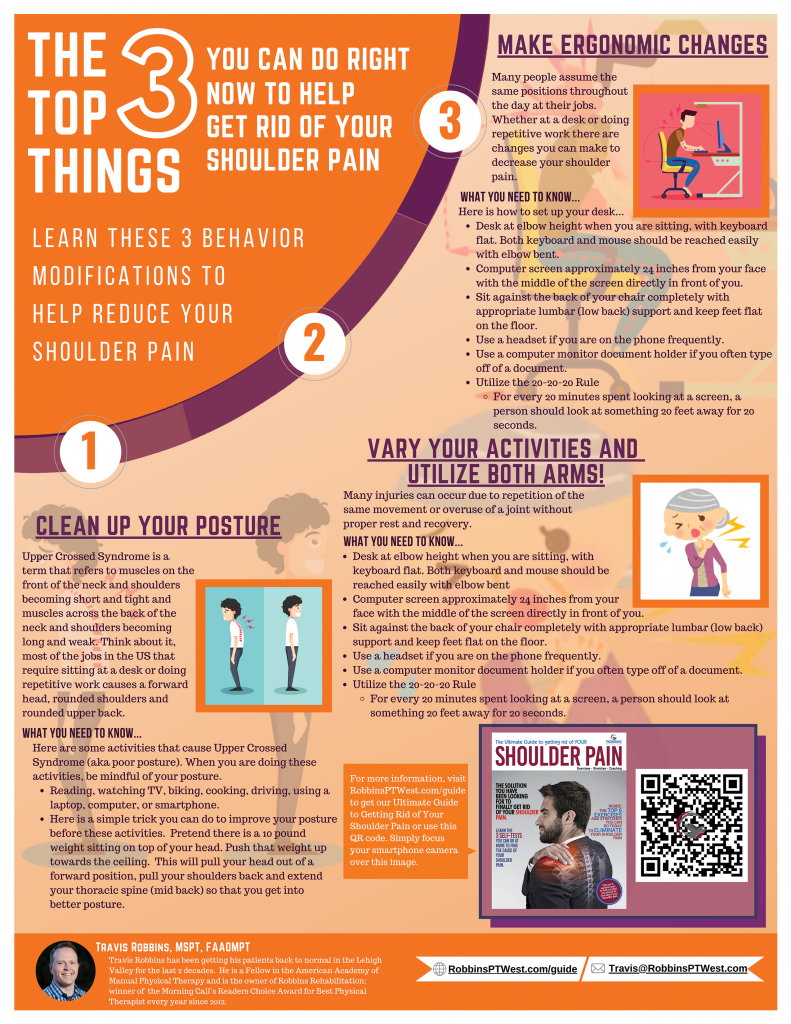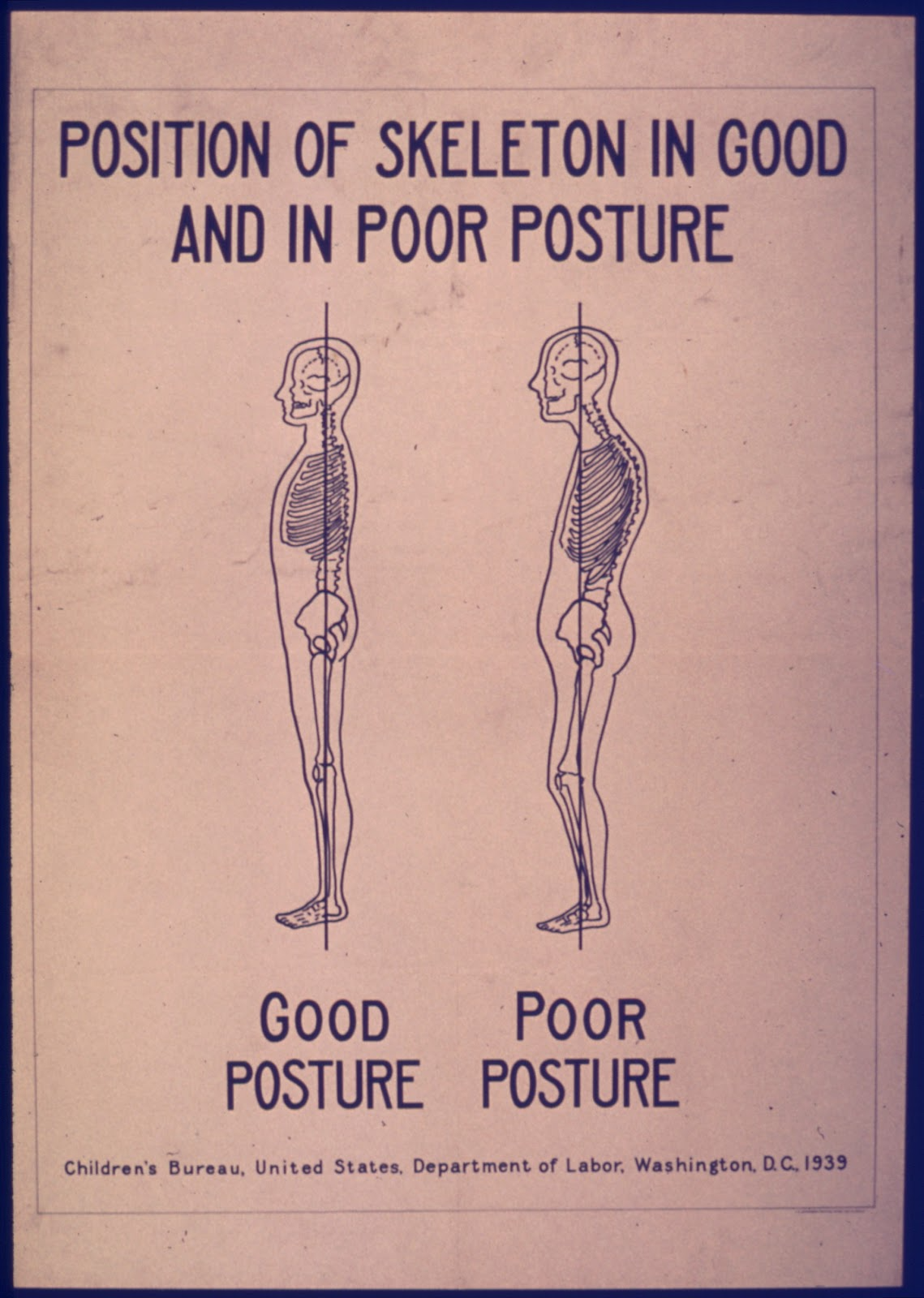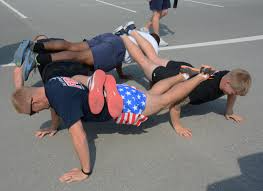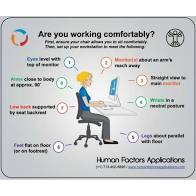
1. Utilize good posture
- Upper Crossed Syndrome is a term that refers to what occurs when the muscles in the neck, shoulders, and chest become deformed – usually as a result of poor posture. Poor posture can have many effects on our overall health, one of those being shoulder pain. Due to the majority of jobs in the United States requiring people to sit at a desk many of those workers begin to assume a posture that consists of a forward head, rounded shoulders, rounded upper back, and slumped lower back. When people assume these positions repetitively or over a prolonged period of time they begin to change the way we sit and stand all the time.

- Chronically poor posture places the other surrounding joints in different positions which leads to shortening of some muscles and weakening of others.
- Typical shortened and overactive muscles include: pectoralis major and minor, upper trapezius, levator scapula
- Typical weak muscles include: lower trapezius, middle trapezius, rhomboids, shoulder external rotators
- Activities that cause Upper Crossed Syndrome (aka poor posture)
- Reading, watching TV, biking, driving, using a laptop, computer, or smartphone

2. Vary your activities and utilize both arms!
- Many injuries can occur due to repetition of the same movement or overuse of a joint without proper rest and recovery
- Your shoulder is composed of 4 main muscles that are often referred to as the Rotator Cuff – these muscles include supraspinatus, infraspinatus, subscapularis, and teres minor
- These muscles stabilize your shoulder and allow you to move in all different directions. If they are weak or are not allowed to recover after being worked, or if they are put in abnormal positions due to postural changes that have occurred they can become strained or even tear with overuse
- By varying your activities and taking appropriate rest breaks you can utilize more muscles in your shoulders, upper back, and chest to diminish stress placed solely through your rotator cuff. By utilizing both arms – ex: if you carry your purse on your R shoulder all the time it can start to permanently affect your posture. If you are shoveling and always keep your right hand at the bottom and left hand at the top the same muscles are being fatigued repeatedly. Try switching your stance by turning around and putting your left hand at the bottom and right hand at the top for several repetitions before returning to the first stance position. This will enable you to diminish the repetitive stresses placed through your muscles, improving longevity and tolerance to activity.

3. Make ergonomic changes
- Many people assume the same positions throughout the day 5 days per week at their jobs. These positions often involve sitting at a desk looking at a computer. When we assume a posture for prolonged periods of time our body starts to adapt to make this the posture we assume at home, at work, and when doing other sitting activities like driving.
- Key Points for Desk Setup:
- Desk at elbow height when you are sitting
- Computer screen approximately 24 inches from your face (approximately 1 arms length) with the middle of the screen directly in front of you
- Keyboard should be flat on the desk and you should be able to reach your mouse with your elbow still bent
- Sit against the back of your chair completely with appropriate lumbar support
- Feet flat on the floor
- Use a headset if you are on the phone frequently
- Use a computer monitor document holder if you often type off of a document
- If you use multiple screens ensure that they are evenly split in front of you, or you can turn your chair to look directly at the one you are mainly using
- Utilize the 20-20-20 Rule
- For every 20 minutes spent looking at a screen, a person should look at something 20 feet away for 20 seconds.
- If you are frequently standing at your job, lifting heavy objects, or reaching overhead:
- Lift with proper technique bending at your hips and knees
- Ensure weight is appropriate and safe for you to lift independently
- ASK FOR HELP if you cannot safely lift something alone
Are you looking for more information and someone to tell you what is going on with your shoulder pain!? Come in for a free screen with one of our therapists.
It’s a 30 minute 1-on-1 appointment with a Physical Therapist where you get the following…
1. A DIAGNOSIS: Discover the cause of your pain so that you can attack the problem successfully.
2. A PROGNOSIS: Find out how long it will take to fix your shoulder pain for good so you can get back to all the activities you used to do before your injury.
3. A PLAN: Your Physical Therapist will lay out a clear plan that outlines what will be required to get you back to normal.
All you need to do to get started is to call (610) 839 – 8764 and pick your time and location. We look forward to meeting you and getting you back to normal!


